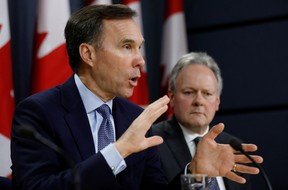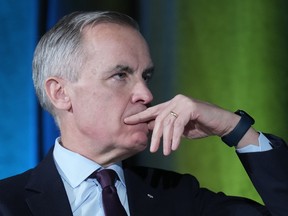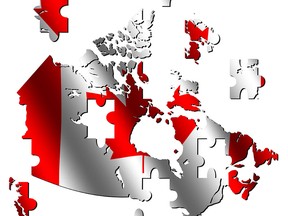In an excerpt from his book ‘The Next Age of Uncertainty,’ the former head of the Bank of Canada looks at the lessons learned during the COVID crisis and what’s needed to face the rising risks ahead
Article content
The following is excerpted from The Next Age of Uncertainty by Stephen Poloz, published by Allen Lane Canada, a division of Penguin Random House Canada
Advertisement
This advertisement has not loaded yet, but your article continues below.
Article content
When major economic convulsions occur — as seen during the pandemic — it falls to governments and central banks to cushion the blow for individuals and companies. This is a form of insurance that uses resources, too.
The history of using government stabilization policies to iron out fluctuations in the economy when it is disturbed is relatively short. This part of economics was advanced first by John Maynard Keynes during the Great Depression and put into regular practice after World War II. Accordingly, the entire history of stabilization policies overlaps with the postwar baby boom. What this means is that governments and central banks have almost always been able to rely upon new economic growth, fuelled by a growing workforce from below, to resume after a recession.
Advertisement
This advertisement has not loaded yet, but your article continues below.
Article content
In that very basic sense, the next age of uncertainty may prove to be especially fraught for policymakers because there will be more and larger fluctuations in the economy to iron out, along with the rising fiscal burdens associated with our first tectonic force, population aging.
As policymakers have learned, some past crises have led to the reinvention of economics itself, such as when both unemployment and inflation rose simultaneously in the 1970s. The lessons from the Global Financial Crisis were applied very well during the COVID-19 crisis. There were some lessons learned from this crisis, too, that no doubt will carry forward into the post-pandemic world.
One key lesson from the COVID-19 episode is that fiscal policy is more effective when it kicks in automatically
One key lesson from the COVID-19 episode is that fiscal policy is more effective when it kicks in automatically, instead of the usual long implementation lag. In the U.S., there were hot debates in both houses of Congress about how fiscal tools should be deployed during the pandemic, leaving the Federal Reserve to shoulder much of the stabilization burden in the early months of the crisis. Canada performed relatively well in this sense, but there were still meaningful lags in implementation of support programs. Importantly, the design of Canada’s main fiscal tools during the pandemic — making them elastic, or responsive, to the underlying conditions — was a major step forward in fiscal effectiveness. Employment insurance was always intended to be an automatic stabilizer in this sense, although it operates with more of a lag than some of the programs put in place during the pandemic. In contrast, in the U.S., as the second wave of COVID-19 hit the economy, there was a completely new political cycle of debate before a second wave of government support could be rolled out. Maintaining a higher degree of automaticity in future fiscal frameworks would reduce the load on monetary policy over time.
Advertisement
This advertisement has not loaded yet, but your article continues below.
Article content

Another key fiscal learning from the pandemic is that even though an emergency may dictate that the standard fiscal accountability framework around debt and deficit objectives be set aside temporarily, there is still a fundamental need for one. Governments need to offer continuous insight into the fiscal future to help markets form expectations. After all, governments are asking investors to finance expenditures of previously unimagined scale. At a minimum, governments must lay out a credible fiscal plan, showing the likely paths for government indebtedness and how it will be financed, regardless of how bad the situation may look. Offering good and bad scenarios to complement the base scenario is also good practice. Given this framework, the minimum requirement for fiscal sustainability is to make a commitment to stabilizing the ratio of debt to national income or gradually lowering it from its peak as economic growth picks up. This commitment would translate into near-term objectives for government spending and the fiscal deficit.
Advertisement
This advertisement has not loaded yet, but your article continues below.
Article content
In terms of monetary policy, the lessons from the Global Financial Crisis played a key role in defusing the COVID-19 economic crisis quickly. Central banks deployed their full array of market intervention tools rapidly and in force, whereas during 2008 the response was more sequential. Further, many countries made use of negative interest rates. Prior to the 2007–08 Global Financial Crisis, it was widely believed that the lower bound for interest rates was zero, or even slightly above zero. However, central banks in many countries have pushed short-term interest rates below zero, and rates on government bonds have followed, shattering this previously held view. The concept of paying interest in order to borrow is so deeply ingrained in us that many find it hard to wrap their minds around a negative rate of interest. There is nothing natural about a negative rate, as the underlying natural rate of interest is a measure of impatience, which remains a human characteristic. But in extraordinary conditions, moving rates below zero can provide more stimulus to the economy. Because banks borrow and lend long, what matters most to the functioning of the financial system and the supply of credit is the spread between the rates at which banks borrow and lend. Provided that there is a reasonable spread, banks continue to do the job. Moving central bank rates below zero pulls lending rates down even further and encourages households and firms to borrow and spend, thereby helping the economy climb out of a recession.
Advertisement
This advertisement has not loaded yet, but your article continues below.
Article content
Nowadays, it is understood that the effective lower bound for interest rates is related to the cost of managing cash balances — secure storage of banknotes and insurance against loss. Someone with money in a bank earning negative interest can move their funds into cash and earn zero interest instead, but needs to store the cash. Taking these storage costs into account, most research puts the effective lower bound for the nominal interest rate at around minus 0.5%, or possibly a little lower.
Regardless of the exact lower bound for rates, it is important to understand that when rates are very low, central banks have much less room to manoeuvre if something goes wrong in the economy. Consider a scenario where there is a shock to the economy, unemployment rises, and inflation appears likely to decline below a central bank’s target. The authorities will push rates down to encourage more borrowing and faster growth to offset that shock. If interest rates start at, say, 4 per cent, then the central bank can cut rates by at least four hundred basis points and give the economy a sizeable boost. But if rates start at 2 per cent, cutting interest rates to zero will only do half as much work. The ability to cut rates below zero gives another fifty basis points of manoeuvrability.
Advertisement
This advertisement has not loaded yet, but your article continues below.
Article content
It is usual to think of disturbances hitting the economy as symmetric around zero; in other words, over time, good and bad luck tend to average out to no luck at all. The lower interest rates are, the more likely it becomes that central banks will not be able to cut rates by enough to cushion the blow when bad luck happens. However, they have complete freedom to raise interest rates, so good luck can be absorbed by raising rates as much as necessary. The lower bound for interest rates introduces an asymmetry into the monetary policy process, which could mean that the central bank is frequently unable to achieve its inflation target when the average level of rates is low. Central banks have other tools in their arsenal that can supplement interest rate adjustments, such as quantitative easing, but these tools have only second-order effects on the economy. Economic research is pointing to a heavier use of fiscal tools to stabilize the economy in the future, when interest rates are likely to remain low on average. Essentially the same analysis was offered by John Maynard Keynes in the 1930s.
Advertisement
This advertisement has not loaded yet, but your article continues below.
Article content
The ability of central banks to smooth out business cycles will be less in future than in the past
Meanwhile, the tectonic force of rising household indebtedness will continue to pose challenges for monetary policy. A high level of private sector debt in the economy makes it more vulnerable to downturns — a company with no debt can ride out a storm of negative economic volatility, whereas an indebted company may be unable to service its debt and be forced to close. High debt magnifies the consequences of a disturbance to the economy, which makes it harder for the central bank to keep it on track. A related complication is that prolonged low interest rates generally lead to what seems like excessive risk taking as many actors search for yield. This applies as much to households as it does to firms. While some cautious firms might see low yields as a reason to walk away from investment opportunities, others may find it necessary to reach far outside their risk comfort zone in order to achieve what they consider to be a reasonable return on capital. Such risk taking makes the economy highly vulnerable not only to bad luck but to interest rate increases. The possibility that even a modest interest rate rise could cause an outsized round of business failures and job losses can severely constrain the central bank’s ability to stick to its inflation targets.
Advertisement
This advertisement has not loaded yet, but your article continues below.
Article content
-

Prices are rising, but here’s why Stephen Poloz isn’t too concerned about it
-

Trudeau government’s deficit spending wins Stephen Poloz’s praise as ‘sustainable’
-
Inflation surges past five per cent, adding pressure on the Bank of Canada to raise interest rates
In light of the risks associated with debt, some commentators have recommended that central banks keep interest rates higher on average, so households and firms take on less debt. However, a central bank can really only pursue its inflation objectives, while smoothing out economic fluctuations along the way. Trying to limit the rise in debt at the same time is usually a recipe for underachieving the inflation target. That is why governments and central banks have developed a suite of macro-prudential tools, such as mortgage stress tests or maximum loan-to-income guidelines, to limit future vulnerabilities of the financial system and to leave the central bank to pursue its inflation targets. In the limit, a full synthesis of the trade-offs faced by the central bank — one that captures both macroeconomic (output-inflation) risk and financial risk due to debt vulnerabilities, bound together through private sector behaviour — remains an objective of economic modellers. In the meantime, a reasonable approximation can be achieved by capturing financial stability risk within the central bank’s objectives, provided it is given additional tools to address them independently.
Advertisement
This advertisement has not loaded yet, but your article continues below.
Article content
The ability of central banks to smooth out business cycles will be less in future than in the past, given the tectonic forces acting on the economy. This room to manoeuvre will decline at the same time that the volatility that policymakers need to deal with increases due to the interaction of the tectonic forces. Given this challenging environment, achieving the same degree of macroeconomic stabilization as in the past is likely to prove impossible for the central bank working alone and therefore will require fiscal policy to be unusually flexible. One way to tackle this would be to make fiscal policy more automatic, responding to variability in the economy without the need for new legislation. A universal basic income program could be designed to do exactly this. However, more automatic fiscal tools may run up against the nature of politics, where it is better to get credit for fixing a problem than to see the problem get defused automatically and still have to defend the resultant fiscal deficits. The stresses associated with sharp fluctuations in government deficits — both up and down — are likely to be even more acute given the rising baseline fiscal burden.
Excerpted from The Next Age of Uncertainty by Stephen Poloz. Copyright © 2022 Stephen Poloz. Published by Allen Lane Canada, a division of Penguin Random House Canada Limited. Reproduced by arrangement with the Publisher. All rights reserved.
Advertisement
This advertisement has not loaded yet, but your article continues below.
Tectonic forces are working on the economy that central banks can’t battle alone: Stephen Poloz
2022-02-18 11:00:24






